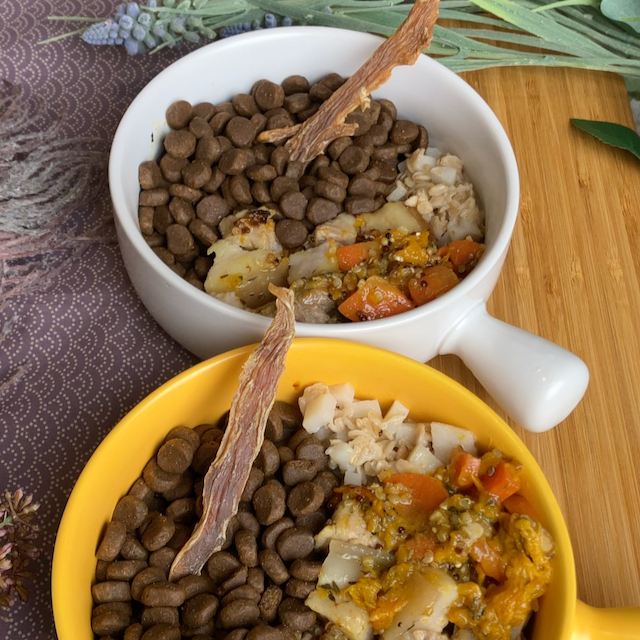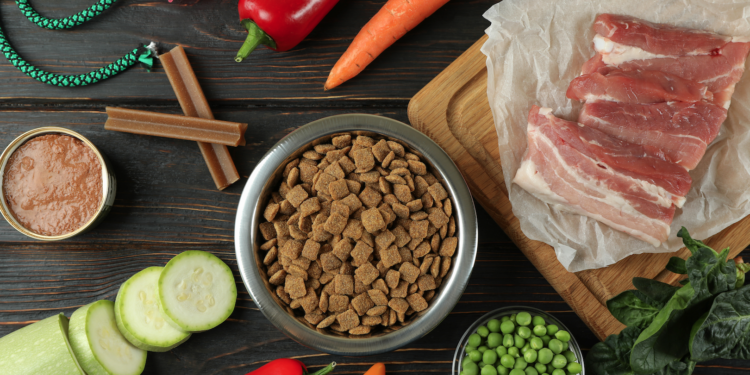This is what we consider when choosing what and how to feed our dogs:
- is it real food ~ food that we would eat ourselves?
- digestibility ~ how much of the ingredient is absorbed and properly used by the body?
- is the food supporting all bodily functions ~ immune system, nervous system, brain health, skin & coat health, dental health, healing & regeneration
DRY FOOD
- usually made by mixing together a number of dried, flaked or powdered ingredients to form a dough which is then cooked with high heat and high pressure
- a coating of fat or other enhancers are often sprayed on after
ADVANTAGES
- convenient
- long storage times
POSSIBLE CONCERNS
- not real food
- digestibility is questionable
- contain 6%-12% moisture so dogs need to drink a lot of water to compensate
- often has significant levels of starch
- do not want our dogs to be eating dry biscuits day after day
WET FOOD
- meat and fat ingredients are blended with measured amounts of water
- textured vegetable protein (fake meat) and dry ingredients are then added before the entire mixture is heated at high temperatures for extended durations
ADVANTAGES
- convenient
- long shelf-life
- highly palatable
POSSIBLE CONCERNS
- textured ingredients that look like meat but are not
- often has significant levels of starch
- although better than dry food, digestibility is also questionable
HOMEMADE DIET
- prepared using human grade meats, vegetables, grains and fat
- some follow the same recipe, with little adjustments, repeatedly
- others opt for diversity and use a variety of recipes
ADVANTAGES
- real food
POSSIBLE CONCERNS
- may be nutritionally incomplete because of gaps in nutrition awareness of pet parents
- expanded view on fat, oils, minerals and vitamins needed
- repeated feeding of the same recipe may reenforce nutrition gaps
- may be nutritionally incomplete based on minimum nutrition levels set out by AAFCO/FEDIAF*
* can be complicated to understand so pet parents are unaware or unable to prepare homemade meals that are ‘nutritionally complete’
RAW DIET
- lean meats, whole fish, organs, raw meaty bones, vegetables, seeds and oils
ADVANTAGES
- real food
- raw meaty bones and carcasses are great for dental health
OUR CONCERNS
- may be nutritionally incomplete* because of gaps in nutrition awareness of pet parents
- improved understanding about fat, oils, minerals and vitamins will help
* based on minimum nutrition levels set out by AAFCO/FEDIAF which can be complicated to understand – this presents a challenge to pet parents making them unable to prepare homemade raw meals that are ‘nutritionally complete’
MIXING IT UP

- mixing kibble with cooked food -or- wet food with raw -or- cooked food with raw
ADVANTAGES
- real food
- convenient
- diversity is good for the gut
POSSIBLE CONCERNS
- may be nutritionally incomplete or unbalanced if ingredients add too much starch, fat or fiber
OUR APPROACH
We believe diversity is key to stronger and happier bellies.
- we cook a different recipe for dinner each day
- the girls often get freeze dried raw food + milk + oils + seeds for breakfast
- they get raw meaty bones about twice a week
- they sometimes get raw meat added to their meals
- we sometimes add a little dry kibble or wet food to their meals as a treat
- when we are busy or travelling, the girls get dry food or freeze dried raw food mixed into a soup of blended vegetables, oils and milk (cow, goat, soy, almond or rice)
REAL FOOD
We use real foods as a first choice to meet the minimum nutrition levels set out by AAFCO/FEDIAF as much as possible. But we are not sticklers to feed guidelines as we believe our pets’ body systems are much more capable than the industry gives them credit for.
If You Enjoyed Our Content
please consider buying us a coffee / sending us dog treats
Content Notice
Articles and videos are Informational only and not intended to replace professional veterinarian advice. Always consult a veterinarian or veterinary practitioner regarding your pet’s health and nutrition.



